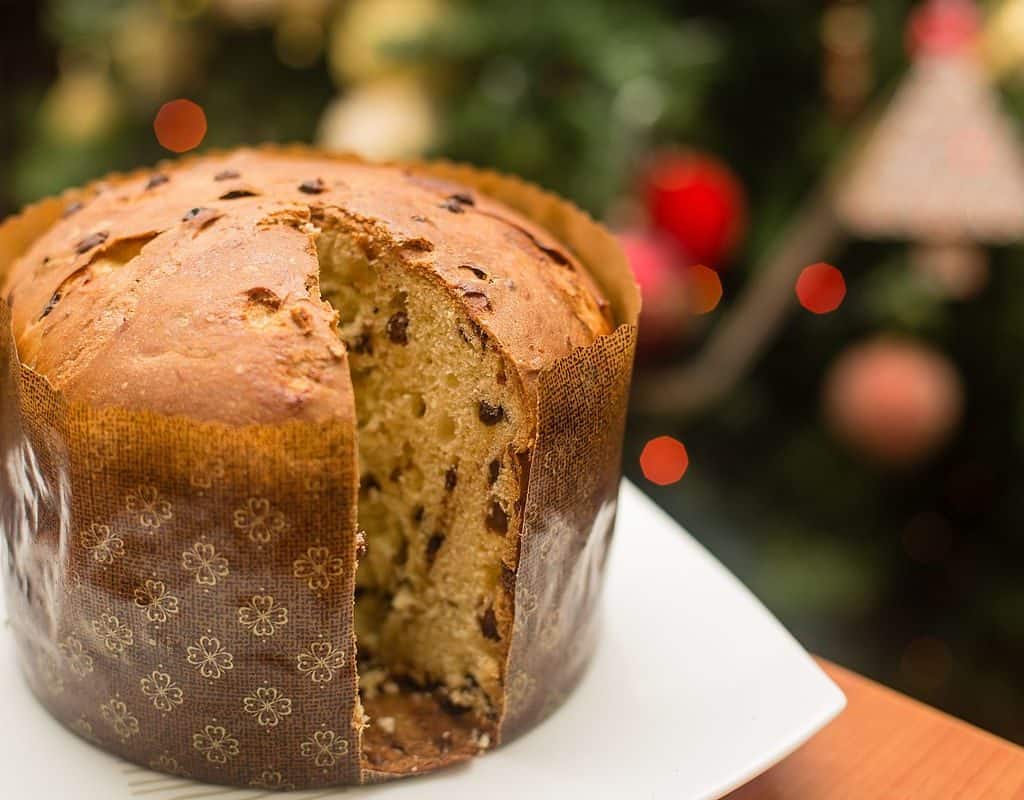For many families, Christmas Panettone (or sweet bread in Italian) is a symbol of Christmas celebrations. This sponge cake, with or without raisins, candied fruit, or chocolate chips, is a staple on the tables of Europe and South America during the Christmas and New Year holidays.
Origin and history of Christmas Panettone
Apart from its Italian origin, little is known about its provenance.
One of the best-known legends in Italy claims that Toni, cook of the Duke of Milan Ludovico Sforza, known as “Il. Moro“, at the end of the 15th century, was the creator of one of the nation’s most emblematic desserts.
The Sforza court celebrated with a lavish banquet on Christmas Eve 1495. The chef was busy in the kitchen preparing various delicacies when he asked his young assistant Toni to check the oven, where huge sponge cakes were being baked for the duke’s dessert.
However, Toni, exhausted by the work, falls asleep briefly and the biscuits burn.
The young cook decides to sacrifice the yeast dough he had saved for the Christmas bread for fear of the chef’s reaction and the guests’ impatience to eat.
To create a soft, highly fermented dough, he works it with flour, eggs, sugar, raisins and candied fruit. He then bakes it and serves it at the banquet.
Toni’s bread
The result was a resounding success and Ludovico Sforza decided to honor its creator by naming this dessert “Toni’s bread”. Then, as time went by, “Toni’s bread” acquired notoriety as “Panettone” all over Italy.
But what is the basis of this myth? Massimo Montanari, professor of food history at the University of Bologna (Italy), answers: “Absolutely nothing”. It is one of the many false news that is spread about the place of origin of many culinary products.
“The bread of the feasts” medieval roots
According to Montanari, there are two types of products: those that have a known date of birth and clear inventors and those that do not.
In the first category are products such as “Pandoro“, which in Italian slang means “Golden Bread” in the Veneto region and whose recipe was submitted to the patent office in 1894 by Domenico Melegatti, from Verona.
Moreover, since the Panettone recipe is a product of collective tradition, it is impossible to pinpoint the exact place and time of its creation.
The genealogy of Panettone
But, as Montanari explains, it is possible to build the genealogical tree of Panetón and go back to its origins in the Middle Ages.
The “sweetbreads” or “festive bread” are bread to which sugar, raisins, or spices are added and which are consumed when important holidays, such as Christmas, are celebrated.
A manuscript from the 1470s now preserved in the Biblioteca Ambrosiana in Milan is one of the earliest records attesting to the existence of this sweet bread.
Giorgio Valagussa, author of the book and preceptor to the Sforza dukes, describes the “ritual of the wood” that was practiced at that court. According to Valagussa’s text, on the night of December 24, large loaves of sweetened wheat bread were served together with a large log of firewood.
As a sign of continuity, the head of the family served a portion to each guest and kept another for the following year. The author of several books on the history of some of the best-known dishes of Italian cuisine, Monatanari, explains:
“On the one hand, there was an element of connection with the staple food of everyday life, bread and on the other, ingredients and spices that made them ‘precious,’ according to the taste of medieval or Renaissance times.”
The connection between Panettone and the city of Milan
Although the connection between Panettone and Milan is undeniable, one cannot claim exclusivity, because the same traditions have been documented in other parts of northern Italy.
However, it was not until the beginning of the 20th century that the consumption of Panettone during the Christmas holidays became widespread throughout Europe, partly thanks to the innovations of the ingenious Milanese baker Angelo Motta.
In 1919, Motta decided to add yeast to the traditional recipe, which calls for the dough to rise for more than 30 hours before baking. He also wrapped the dough in special baking paper, giving it its current high dome shape instead of the traditional flat shape.
Another baker, Gioacchino Alemagna, who also gave his name to a well-known company that is still in business, modified Motta’s recipe around 1925.
The intense competition between the two bakers led to the start of the industrial production of this sweet, which has since become one of the most appreciated foods on Italian tables.
Arrival in South America
According to data from the Unione Italiana Food employers’ association, almost 42,000 tons of Panetones were sold in the European nation in 2018. But thanks to the millions of Italian emigrants who crossed the Atlantic between the late nineteenth and mid-twentieth centuries in search of opportunities in South America.
The success of this dessert long ago crossed the borders of Italy and has established itself as a Christmas tradition also in several South American countries such as Brazil, Argentina, Uruguay and Peru.
The D’Onofrio brand
The name D’Onofrio is comparable to that of Pietro D’Onofrio, an immigrant from southern Italy who settled in Peru and started the ice cream business that bears his name to this day.
However, it was his son Antonio who, in the 1950s, negotiated an agreement with the Milanese company Alemagna to manufacture and market Panetón under the D’Onofrio name in Peru.
Ricardo Bassani, director of Nestlé Peru’s confectionery division and owner of the D’Onofrio brand and three other Panetón companies in the country since 1997, forecasts that Peruvians will consume more than 35 million units this year.
“One of the groups that consume this cookie the most is Peruvians. Our annual consumption is 1.1 kg per person, which makes us the second largest consumer nation, only behind Italy,” continues the executive, who adds that the Peruvian panettone market is valued at US$200 million.
Brazil, with about 440 grams per person per year, is the nation that consumes the most Panetón, after Italy and Peru. Moreover, Bauducco, based in Brazil, is the company that produces the most Panetón in the world.
Another Italian immigrant, Carlo Bauducco, founded the company in São Paulo in 1952. It now employs more than 6,000 people in Brazil and the U.S. has an annual production capacity of more than 300,000 tons and generates more than $700 million in revenues.




